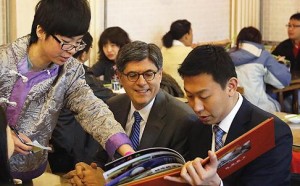 Looking back at 2016, the news story that overwhelms all others (at least in the USA) is the election of Donald Trump to the Presidency of the United States. The surprise and shock was universal, due to the near certainty in national polls that Hillary Clinton would be the winner. And, in fact, she was in the popular vote, by nearly 3 million votes. Maybe it should not have been such a surprise, given the similar upset win in the Brexit vote, which in showed the similar growing momentum of nationalism and anti-immigrant sentiments as evinced in the Trump campaign. That same movement is evident in other countries as well, such as Italy (upset loss of constitutional referendum), France (rise of LePen and the Front National), and Germany (electoral victories in regional elections by the “Alternative for Germany”). These movements have gained through electoral victories a kind of legitimacy that would have seemed impossible in the recent past. Along with that new political power comes a sense of empowerment to voice openly anti-immigrant, racist, and misogynous views – after all, if the President–elect has made similar pronouncements, doesn’t that put such talk and tweets into the main stream of public speech?
Looking back at 2016, the news story that overwhelms all others (at least in the USA) is the election of Donald Trump to the Presidency of the United States. The surprise and shock was universal, due to the near certainty in national polls that Hillary Clinton would be the winner. And, in fact, she was in the popular vote, by nearly 3 million votes. Maybe it should not have been such a surprise, given the similar upset win in the Brexit vote, which in showed the similar growing momentum of nationalism and anti-immigrant sentiments as evinced in the Trump campaign. That same movement is evident in other countries as well, such as Italy (upset loss of constitutional referendum), France (rise of LePen and the Front National), and Germany (electoral victories in regional elections by the “Alternative for Germany”). These movements have gained through electoral victories a kind of legitimacy that would have seemed impossible in the recent past. Along with that new political power comes a sense of empowerment to voice openly anti-immigrant, racist, and misogynous views – after all, if the President–elect has made similar pronouncements, doesn’t that put such talk and tweets into the main stream of public speech?
It will be interesting to see if Twitter – used in such a mean-spirited way by Trump –will lose any of its luster as an instrument of personal outreach and self-promotion through such an example. Of course the other significant influence on the election through technology was on the other side – Clinton’s email debacle. In point of fact, neither candidate can be considered digitally literate: Trump is said to have never used a computer, while Clinton is a notorious technophobe. Both camps, however, did include highly competent tech folks, who took care of promotion through social media and the use of data analysis to guide internal polling, advertising spending, and the get out the vote ground game. The conventional wisdom was that the Clinton campaign had in these areas an overwhelming advantage, with data analysis expertise much better than that on the other side. Since the Trump win, the media have been revising that view.
While the Clinton campaign’s decisions on where to spend time and money were based on models of likely voters based on voter-registration files, supplemented by tracking polls, the Trump camp used a different, more flexible strategy, based on evidence from local canvassers and early voter trends. According to Ed Kilgore, the Clinton approach “tends to create a more static view of the electorate and its views, and probably builds in a bias for thinking of campaigns as mechanical devices for hitting numerical ‘targets’ of communications with voters who are already in your column.” The Trump camp approach was more nimble and more technically up-to-date, at least as described in an interview on NPR by Brad Parscale, the data guru for Trump:
If you had an app on your iPhone or Android, you could go knock doors. And when you knock that door, you push a button on your iPhone – you talked and communicated with this person. It would immediately send back to our database, so now we know we don’t have to communicate with that person in another method, where Democrats still use pieces of paper that have to be scanned in and then databased later. So they weren’t getting real-time information on their door-knocking program. That’s a huge advantage for us into our ground game.
In the days leading up to the election, I was surprised that Trump was spending money and putting in time in “safe” Clinton states like Wisconsin and Michigan, which polls showed were securely Democratic, at least as far as the presidential race was concerned. But Parscale and his team were seeing shifts in local preferences and voting trends that weren’t being picked up by others. In the end, it was those Americans who were dismissed as unlikely to vote who made the difference. The next electoral go-around will see the application of lessons learned from 2016, not least of which will be in the area of technology: 1) It’s great to have a state-of-the-art data-driven model for guiding the direction of the campaign, but that model better be able to note and take into account subtle and last minute changes in trends and voter behavior; and 2) Speed in some instances is key, and apps feeding directly and instantly into a central data base in the cloud beat the pants off “pieces of paper”.
I’m in the process of writing a column for Language Learning & Technology on “big data” and learning analytics. In education, too, good decisions in technology use can have a profound influence on success. These days, that means increasingly looking to data-driven evidence of what works and what doesn’t.
 Interesting news story in the New York Times today, about the increased sales of George Orwell’s novel, 1984, in which a totalitarian state has absolute control over news dissemination, using “newspeak” to provide the view of reality the state wants to project, in the novel called “reality control”. Apparently, the surge in interest is related to the use by Trump advisor Kellyanne Conway of the term “alternative facts”, in defense of the false claim by White House press secretary, Sean Spicer, that Mr. Trump had attracted the “largest audience ever to witness an inauguration.” This first week of the Trump presidency has brought other “alternative facts”, such as that there were 3 to 5 million fraudulent votes in the presidential election, an explanation the President gives for losing the popular vote.
Interesting news story in the New York Times today, about the increased sales of George Orwell’s novel, 1984, in which a totalitarian state has absolute control over news dissemination, using “newspeak” to provide the view of reality the state wants to project, in the novel called “reality control”. Apparently, the surge in interest is related to the use by Trump advisor Kellyanne Conway of the term “alternative facts”, in defense of the false claim by White House press secretary, Sean Spicer, that Mr. Trump had attracted the “largest audience ever to witness an inauguration.” This first week of the Trump presidency has brought other “alternative facts”, such as that there were 3 to 5 million fraudulent votes in the presidential election, an explanation the President gives for losing the popular vote.












